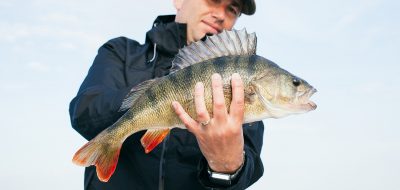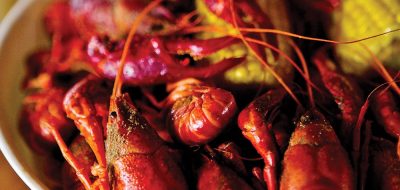If you tour Cajun Country you’re bound to encounter crawfish. It’s as inevitable as BBQ in Texas, lobster in Maine, beans in Boston, or potatoes in Idaho.

Between every row in a flooded rice field is a long line of traps with bright orange tops that poke out of the water every few feet. © Rex Vogel, all rights reserved
Crawfish, mudbugs, crawdads, or crayfish—call them what you will—are woven into Cajun culture.
They raise them, catch them, eat them, and sing about them. They even adopt them as the official state crustacean (July 1983). And for a critter that impacts the state economy to the tune of $120,000 million annually, the adulation seems about right.
Crawfish are native to the Louisiana coast, where open water provides a perfect habitat for the crustaceans to burrow and grow.
Rice has been a mainstay of Louisiana agriculture since the 18th century. It is one of the few crops the wet and silty soil is able to support.
For years, crayfish was a wild product, harvested mostly in the Atchafalaya Basin. In the 1970s and ’80s, farmers realized that they could make extra money by managing the crayfish that already lived in their flooded rice fields.
Between every row is a long line of traps with bright orange tops that poke out of the water every few feet. They are there because the primary crop is the crayfish teeming in the shallow water. The rice is just there to feed them.
Crawfish production in Louisiana is now predominately done from crawfish farms.
Louisiana leads the nation in crawfish aquaculture, with approximately 1,600 farmers producing around 90 percent of the US domestic crop.
There are two main crawfish species in Louisiana—red crawfish and white crawfish. Red crawfish far outnumber white crawfish in statewide production. Occasionally both species appear mixed in the same catch.

Typical pyramid trap design made from vinyl-coated, ¾-inch square mesh.© Rex Vogel, all rights reserved
Red crawfish dominate most farms, especially in south Louisiana and in most places in the Atchafalaya Basin. White crawfish are slightly more plentiful on north Louisiana farms and in Mississippi River overflow swamps.
The meat of both species is similar in taste but the fat (hepatopancreas) is different. Red crawfish fat is orange with a rich flavor; white crawfish fat is greenish and slightly less flavorful.
The larger the crawfish are, the lower the tail meat yield percentage will be. This is because as the animal matures, the head and claws become disproportionately larger. Meat yield will be as high as 20 percent on medium animals and as low as 8 percent on very large animals. In spite of this, larger crawfish are much more popular in boiled preparations.
Louisiana cooks make good use of crawfish—in bisques, étouffées, stews, gumbos, stocks, and even pies.
Crawfish Season
Warmer weather and longer days mark the beginning of crawfish season. From late February to early March, you’ll start getting really nice-sized crawfish. Then they hit their peak for the next few months because the tail is much bigger.
The season only lasts until the water warms up; after that, crawfish shells get hard and the meat becomes tough.
From March to May, Louisiana annually harvests more than 110 million pounds of the little lobsters, sending them to backyard boils and upscale plates around the nation.
How to eat crawfish?

Crawfish production in Louisiana is now predominately done from crawfish farms. © Rex Vogel, all rights reserved
If you want to dine on crawfish, there are a few things you should know so that you can blend in with the locals.
To eat a crawfish:
Grab the head with one hand and grab the tail with the other
Gently squeeze the tail end of the body, near the area where it connects with the head
Hold the head steady and gently while twisting the tail
When the meaty end has separated from the head, peel away the top, partially exposed part of the tail, bring the tail meat to your mouth and sink your teeth in
If you want a genuine Cajun experience, suck the head of the crawfish to indulge in the full-flavor of spicy juices.
Either way you choose to eat these mudbugs, you’ll find them tender, tasty, and juicy.
For information about RV parks and campgrounds, check out Good Sam RV Travel Guide and Campground Directory.
Please Note: This is part of an on-going series on Louisiana Cuisine/Travel Ideas
Worth Pondering…
There are two times a day in Louisiana—mealtime and in-between.
—Anon
You May Also Like
- Prime Time RV Increases Market Share
- Bear Sightings in Arizona Prompt Bear Awareness Tips
- Thor Motor Coach Increases Market Share in 2013
- Arizona Signs Find Home at Rubber Ducky RV Resort
- GCT Introduces First Carbon Fiber Composite RV
- EarthRoamer Integrates GOST Security System
If you enjoy these articles and want to read more on RV travels and lifestyle, visit my website: Vogel Talks RVing.





